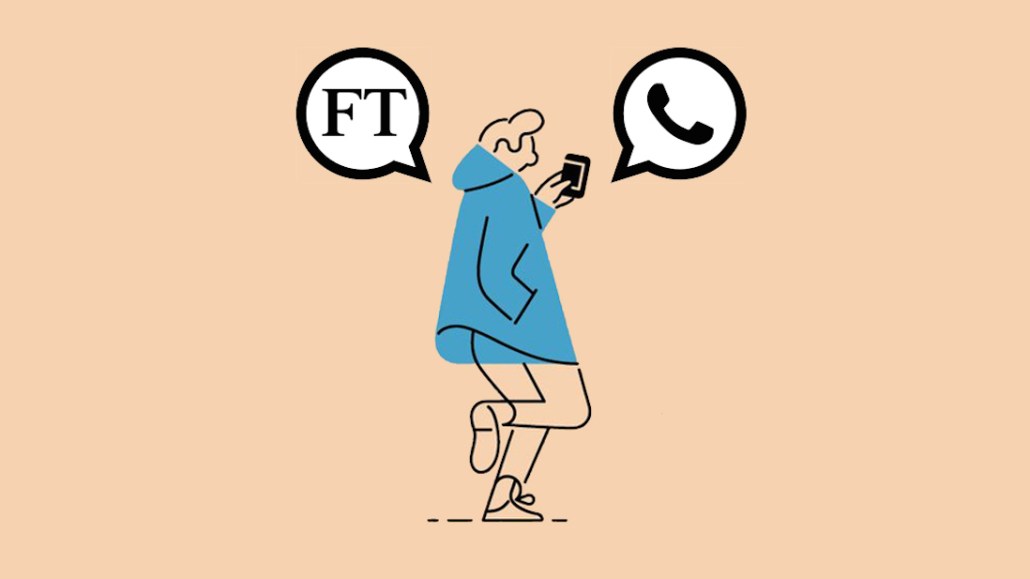Why the Financial Times is going vertical on WhatsApp to drive subscribers

The Financial Times has been broadcasting stories through WhatsApp for the past year as a way of reaching new readers, growing loyalty and driving people back to the FT’s site, where they are more likely to subscribe.
During that time it has honed its content strategy to push out more specific market-related stories, rather than general news, and has found that people who access the FT’s journalism through WhatsApp are more likely to return to its site in the next seven days.
For the last six weeks, after running surveys with its WhatsApp base, the FT has started posting one or two free-to-access market-focused stories a day. Some that have driven the most traffic have been “Why did the pound fall so fast?” “The five market charts that matter for investors” and “Banks begin moving some operations out of Britain.” Stories with charts also do particularly well.
“One of our metrics of success is quality visits — people who come and return within seven days — these people are more likely to become subscribers,” said Alana Coates, audience engagement editor at the Financial Times. The likelihood that readers from WhatsApp will return to the FT within the next seven days is 40 percent higher than the average (a global benchmark set by the FT), although it wouldn’t share absolute figures.
The publisher was unwilling to share the number of people it reaches on WhatsApp. However, it said each post on WhatsApp drives a comparable amount of traffic as a post on its main Twitter account, which has a much higher follower number of 5.7 million.
In January, after the number of WhatsApp users plateaued, the FT paused the account for a few months and surveyed its WhatsApp readers. A quarter of respondents wanted more news on financial markets, which tallied with what the publisher saw in terms of traffic. Tech-related stories, which are often trend analysis or longer features, performed less well than expected. People also wanted them more regularly, twice a day.
This research also told the FT that 80 percent of the people it reached through WhatsApp were non-subscribers. The audience skewed a little younger too, with 36 percent between the age of 26 and 35. They also had more European readers than the FT’s usual footprint: 35 percent were from the U.K., 33 percent from Europe.
“People liked the convenience of having it come through to their phone, pushed to them where they are, without having to go to our site, on a service they are already signed up to,” said Coates, adding that WhatsApp has 1.2 billion users. “The hope was that we get a smaller but more engaged audience.” Publishers, like Spanish newspaper El País and The Sun, are finding chatbots’ more specific content leads to higher engagement.
With the change in content strategy, the FT expected a few people to drop off, but in an encouraging move, the last six weeks it has seen 0.2 percent of the base unsubscribe. The FT, however, will continue to assess audience behavior and adapt its strategy accordingly.
Previously posting to WhatsApp fell under the jurisdiction of the FT’s social media team. Now, it is the responsibility of the journalists on the markets desk, where three editors choose the stories and rotate control of the WhatsApp account. Aside from a few journalists handling specific Twitter accounts, this it a novelty. “There’s been a positive benefit in the culture change,” said Coates. “They think more about the audience, where they are and what they want.”
Publishers have grumbled that WhatsApp is clunky to use as a distribution channel, but Coates explains a third-party company handles the FT’s posting and subscriber sign-up. “It’s worth us making an effort in a place where readers are very active anyway,” she said. “The main thing is the convenience for readers already being on a service.”
WhatsApp is the only FT social channel that uses emojis, which may seem a little out of character, but Coates points out this isn’t flippant since they are related to the content, like a downward chart arrow when market prices fall. “Because it’s a chat app, it feels personal, people use emojis for visual cues, so we do the same. It’s a shortcut for people to understand what’s happening, and it seems to work in this context.”
More in Media

Walmart rolls out a self-serve, supplier-driven insights connector
The retail giant paired its insights unit Luminate with Walmart Connect to help suppliers optimize for customer consumption, just in time for the holidays, explained the company’s CRO Seth Dallaire.

Research Briefing: BuzzFeed pivots business to AI media and tech as publishers increase use of AI
In this week’s Digiday+ Research Briefing, we examine BuzzFeed’s plans to pivot the business to an AI-driven tech and media company, how marketers’ use of X and ad spending has dropped dramatically, and how agency executives are fed up with Meta’s ad platform bugs and overcharges, as seen in recent data from Digiday+ Research.

Media Briefing: Q1 is done and publishers’ ad revenue is doing ‘fine’
Despite the hope that 2024 would be a turning point for publishers’ advertising businesses, the first quarter of the year proved to be a mixed bag, according to three publishers.







